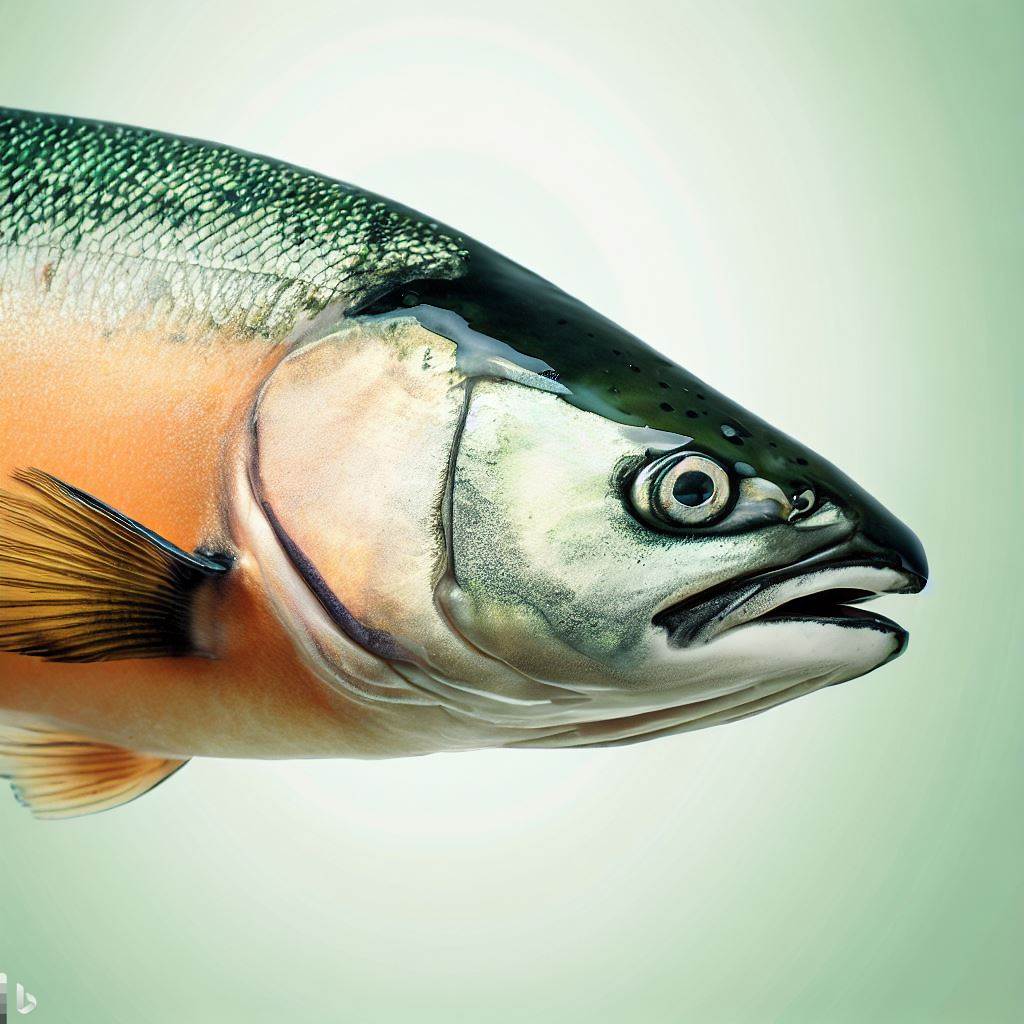Chinook salmon

Within the vast expanse of aquatic existence, the Chinook Salmon (Oncorhynchus tshawytscha) emerges as an exceptional and intriguing species. Renowned as the King Salmon, Quinnat Salmon, or Tyee Salmon, this fish belongs to the esteemed family Salmonidae, encompassing various iconic salmon species. Anglers highly covet the Chinook Salmon for its remarkable size, strength, and delectable flesh.
Anatomy and Physical Attributes
The Chinook Salmon boasts impressive proportions, establishing itself as the largest among all Pacific salmon species. On average, these magnificent creatures measure between 3.9 and 4.9 feet (1.2 and 1.5 meters) in length, with exceptional individuals reaching up to 5.9 feet (1.8 meters). Their weight ranges from 22 to 126 pounds (10 to 57 kilograms), with record-breaking specimens astonishingly tipping the scales at 126 pounds (57 kilograms).
These extraordinary beings exhibit various physical traits that contribute to their dominance in the aquatic realm. Adorned with a sleek body adorned with small, rounded scales, the Chinook Salmon showcases a dark blue-green hue on its back, transitioning to a silver shade on the sides and a white underbelly. Prominent black spots are scattered across its entire body, including the tail fin and upper lobe of the caudal fin.
As an anadromous species, the Chinook Salmon alternates between saltwater and freshwater habitats throughout its life cycle. Their average lifespan spans from three to seven years, contingent upon numerous factors such as water temperature and overall environmental conditions.
Optimal Fishing Times for Chinook Salmon
Determining the ideal fishing times for Chinook Salmon entails considering several factors, including the time of day, weather conditions, and the season. Acquainting oneself with these patterns can significantly enhance the prospects of a fruitful catch.
Spring
During the spring season, Chinook Salmon undertake an arduous upstream migration, venturing toward their native rivers to spawn. This period presents exceptional opportunities for anglers, particularly during the early morning and late afternoon when the fish tend to exhibit heightened activity. Water temperatures ranging from 42.8°F to 53.6°F (6°C to 12°C) prove optimal for this species.
Summer
Throughout the summer months, Chinook Salmon congregate in coastal regions, preparing for their upstream odyssey. Successful fishing during this season necessitates astute consideration of tidal patterns, as the fish are most active during the incoming tide. The preferred water temperature range for summer fishing lies between 50°F and 59°F (10°C and 15°C).
Fall
Autumn heralds the spawning season for Chinook Salmon, beckoning them back to their native rivers. The finest fishing opportunities arise during low light conditions, such as early mornings or evenings. Water temperatures ranging from 46.4°F to 55.4°F (8°C to 13°C) facilitate fruitful catches.
Winter
Although winter generally poses challenges for fishing Chinook Salmon, dedicated anglers can still achieve moderate success. During this time, the fish exhibit a preference for slower movements and less active hunting, adapting to colder water temperatures ranging from 39.2°F to 46.4°F (4°C to 8°C).
Distribution of Chinook Salmon
Chinook Salmon inhabit a vast geographic range, spanning numerous regions along the Pacific coast of North America, from Alaska to California. They also venture into Asian waters, gracing the Bering Sea and the Sea of Japan. Such extensive distribution establishes their substantial ecological presence within both freshwater and saltwater ecosystems.
These incredible fish thrive across diverse habitats, encompassing large rivers, estuaries, coastal regions, and offshore environments. Their adaptability to various conditions contributes significantly to their ecological success and resilience.
Spawning Habits of Chinook Salmon
The reproductive behavior of Chinook Salmon, commonly known as spawning, represents a pivotal stage in their life cycle. These creatures exhibit a remarkable sensitivity to water temperature when selecting the optimal conditions for successful reproduction. Typically, spawning occurs when water temperatures range from 48.2°F to 57.2°F (9°C to 14°C).
Chinook Salmon embark on their challenging upstream journey during fall and spring, skillfully navigating river currents to reach their spawning grounds. Females excavate gravel nests, known as redds, wherein they deposit their eggs. Following fertilization by males, the eggs remain sheltered within the redds until they hatch, usually within several weeks.
Upon hatching, the fry emerge from the gravel and commence their perilous downstream journey to the ocean, where they grow and mature before returning to their natal rivers to repeat the cycle.
Dietary Preferences of Chinook Salmon
Chinook Salmon exemplify formidable predators, boasting a voracious appetite throughout their lifecycle. Their diet primarily comprises small fish, including herring, smelt, and anchovies. They also indulge in a diverse array of aquatic invertebrates, such as shrimp, krill, and squid.
The hunting strategies of Chinook Salmon vary in response to prevailing conditions and prey availability. These astute predators employ a combination of stealth and power, patiently lying in wait to ambush unsuspecting quarry. Their remarkable adaptability enables them to adjust their feeding habits to the ever-changing dynamics of their environment.
Ecosystem Significance
The Chinook Salmon possesses immense ecological value, playing a crucial role in maintaining the delicate balance of aquatic ecosystems. Their predatory behavior serves to regulate populations of small fish and other aquatic organisms, preventing overpopulation and safeguarding the health of ecosystems. Furthermore, the carcasses of deceased Chinook Salmon furnish vital nutrients to various flora and fauna in their habitats, further bolstering the overall ecological well-being.
The cultural, economic, and ecological significance of Chinook Salmon cannot be overstated. These remarkable fish have captivated the hearts and minds of anglers and scientists alike, encapsulating the enthralling intricacies of the natural world. As stewards of our planet, it is incumbent upon us to ensure the continued preservation and conservation of this iconic species, affording future generations the opportunity to appreciate and cherish its enduring legacy.


